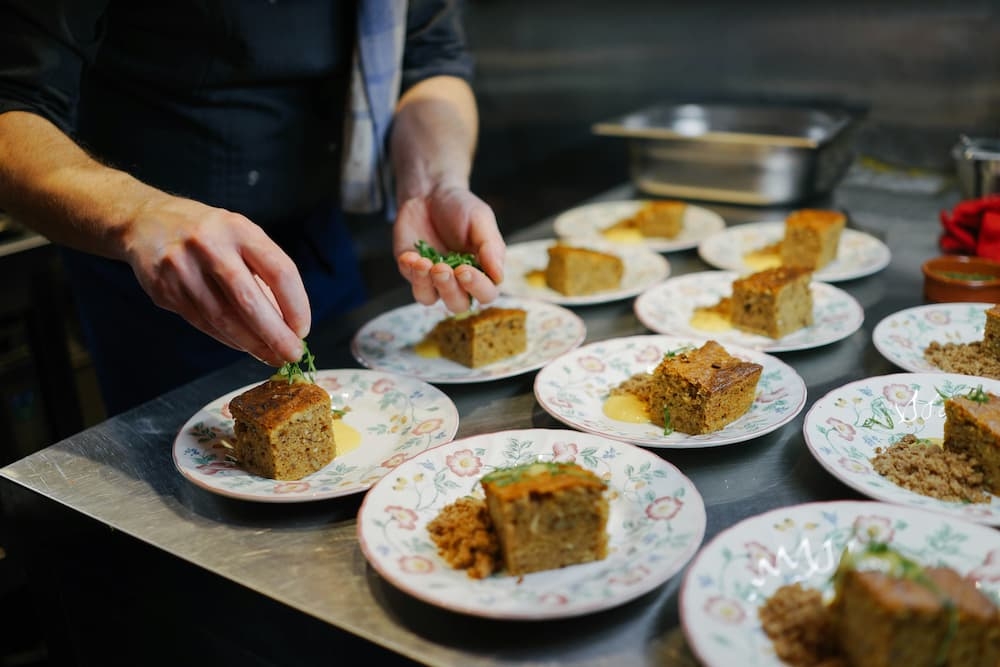From prep to profit: how to optimize food production in ghost kitchens
Table of Contents
CloudKitchens
How many tacos can be delivered from a 1000sqft restaurant?
The same amount as a 200sqft ghost kitchen.
Ghost kitchens have revolutionized the food industry by focusing solely on delivery and takeout orders. As this trend continues to grow, the importance of efficient food production cannot be overstated.
For a ghost kitchen to thrive, optimizing processes, minimizing waste, and maintaining high food quality are critical factors. This article provides actionable tips to ensure your ghost kitchen is set up for success.
Why food production matters in ghost kitchens
In a ghost kitchen, your entire business relies on how efficiently and effectively you can produce food. Unlike traditional restaurants, there’s no dining room to consider, which shifts the focus entirely to back-of-house operations.
Food production directly impacts:
- Delivery speed: Faster preparation means quicker delivery, leading to happier customers.
- Consistency: Customers expect the same quality every time they order.
- Profit margins: Streamlined operations can reduce waste and labor costs, maximizing profitability.
Read more: How to start a ghost kitchen? It’s easier than you think
Key challenges in food production for ghost kitchens
Running a ghost kitchen comes with its unique challenges:
- Space limitations: Ghost kitchens often operate in smaller spaces, requiring creative use of available resources.
- High order volume: Peak hours can create bottlenecks if workflows are inefficient.
- Quality control: Delivering food that looks and tastes as good as it would in a dine-in setting can be difficult.
- Inventory management: Over-ordering leads to waste, while under-ordering risks running out of popular items.
Top food production tips for ghost kitchens
To thrive in the competitive ghost kitchen market, food production must be precise, efficient, and scalable. Below are additional insights to further enhance the strategies outlined:
1. Optimize your workflow
A well-organized workflow is the backbone of a productive ghost kitchen. In a high-pressure environment where speed and accuracy are critical, fine-tuning every aspect of the kitchen layout and processes can lead to significant improvements.
- Workflow automation: Use kitchen display systems (KDS) that show orders in real-time to eliminate manual ticket handling. This ensures accuracy and minimizes errors during peak times.
- Prep ahead: Pre-portion ingredients and sauces to reduce prep time during rush hours. Keep common items ready to go in easily accessible, labeled containers.
- Zoning efficiency: Designate zones for specific tasks like prep, cooking, plating, and packing. Use color-coded containers and tools for further clarity in workflow.
2. Invest in the right equipment
The compact nature of ghost kitchens means every piece of equipment should add maximum value to your operations. The right tools can significantly improve food quality in delivery and preparation speed while saving space.
- Smart ovens: Smart ovens with programmable cooking settings can streamline preparation for different menu items, ensuring consistent results with less manual intervention.
- Vacuum sealers: Use vacuum sealers to portion and preserve ingredients for longer shelf life and reduced waste.
- Energy-efficient equipment: Invest in energy-efficient appliances to lower operational costs, especially for high-use equipment like refrigerators and fryers.
- Delivery-specific tools: Use heat-retentive packaging stations and tools to keep food warm while ensuring it arrives in pristine condition.
Read more: Tips for Proper Food Delivery Packaging
3. Engineer a streamlined menu
Simplifying your menu doesn’t mean limiting creativity, it means focusing on items that deliver maximum impact with minimal complexity. A streamlined menu not only reduces operational strain but also aligns better with the delivery-first model.
- Batch prep-friendly items: Choose menu items that can be batch-prepared without sacrificing quality. Soups, bowls, and pasta dishes are excellent examples.
- Delivery testing: Test new items under delivery conditions to ensure they retain flavor, texture, and presentation when they reach the customer.
- Ingredient overlap: Design your menu with overlapping ingredients to minimize inventory needs. For example, one base sauce can be adapted for multiple dishes with minor tweaks.
- Upsell opportunities: Include add-ons and combos that are easy to prepare, like sides or beverages, to increase average order value.
4. Leverage technology
Technology plays a vital role in the seamless operation of ghost kitchens. By integrating tech solutions into daily operations, ghost kitchens can achieve unmatched efficiency and control.
- Automated order routing: Use platforms that automatically assign orders to the correct kitchen station or brand, minimizing delays and confusion.
- Predictive analytics: Predict demand patterns during peak hours or holidays using historical sales data, helping you prepare accordingly.
- Delivery optimization: Some platforms provide real-time courier tracking and dynamic prep times, ensuring orders are completed just as delivery drivers arrive.
- AI-powered inventory: Invest in AI-driven inventory systems that predict restocking needs and prevent overstock or stockouts.
Read more: Restaurant Technology: Boost your business with the best technology trends
5. Train your staff thoroughly
Even with the best tools and equipment, the success of a ghost kitchen relies heavily on the team running it. A well-trained staff ensures smooth operations, especially during high-pressure moments.
- Cross-training: Train your team on multiple roles to ensure flexibility during peak times. For example, prep staff can help with packing orders if needed.
- Scenario-based training: Simulate busy periods and potential issues like delivery delays or equipment malfunctions to prepare staff for real-world challenges.
- Regular updates: As technology and menu offerings evolve, conduct refresher training sessions to keep staff updated on new tools or processes.
- Team feedback loops: Regularly solicit input from staff on workflow improvements or pain points, creating a culture of collaboration and continuous improvement.
Benefits of optimized food production in ghost kitchens
Efficient food production isn’t just about meeting demand, it creates a strong foundation for long-term success. Let’s explore these benefits in greater detail:
1. Improved customer satisfaction: Efficient workflows and streamlined menus lead to faster order fulfillment and consistent food quality, enhancing the customer experience and increasing positive reviews.
2. Reduced Costs:
- By minimizing ingredient waste and leveraging efficient tools, you can significantly lower operational costs.
- Predictive inventory management prevents over-ordering while maintaining enough stock to meet demand.
3. Higher scalability: Optimized processes allow you to handle more orders during peak times without compromising quality, enabling you to scale up operations and increase profitability.
4. Enhanced profit margins: Focusing on high-margin menu items and reducing inefficiencies can significantly improve your bottom line. Also, leveraging upsells and delivery combos can further increase average order value.
Read more: Top 7 profitable catering food ideas to elevate your business to the next level!
How CloudKitchens can help ghost kitchens thrive
CloudKitchens is designed to empower ghost kitchens with the tools and technology they need to succeed. Here’s how we help:
- Centralized order management: Manage all your delivery platforms from a single tablet, saving time and reducing errors.
- Advanced reporting: Get insights into your sales, order volume, and customer preferences to make data-driven decisions.
- Scalable operations: Run multiple brands from a single kitchen to cater to a diverse audience.
- Efficient workflow tools: From menu management to courier tracking, our platform streamlines every aspect of your delivery business.
Ready to take your ghost kitchen to the next level? CloudKitchens offers the tools and expertise you need to optimize food production, reduce costs, and boost profitability. Discover how CloudKitchens can transform your ghost kitchen operations today!
DISCLAIMER: This information is provided for general informational purposes only and the content does not constitute an endorsement. CloudKitchens does not warrant the accuracy or completeness of any information, text, images/graphics, links, or other content contained within the blog content. We recommend that you consult with financial, legal, and business professionals for advice specific to your situation.
Read more:
- Launch your Virtual Restaurant: A complete guide to success
- Starting a Pop-up Restaurant: A Comprehensive Guide
- Essential tips for safe and efficient food storage in your kitchen
- Waste Management: best strategies for your restaurant
- Mastering demand management: Strategies for handling peak delivery periods
More insights & stories
There’s more where that came from.
Get in the know and check out our additional insights


